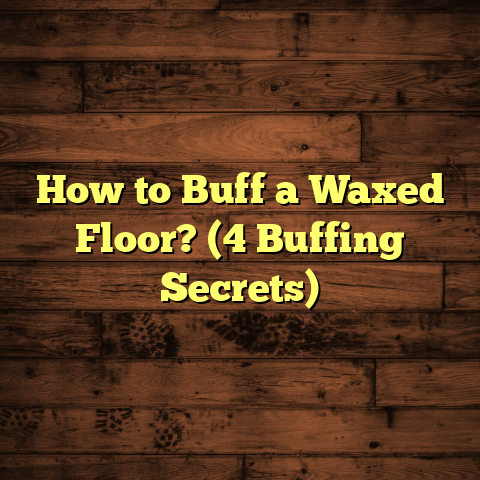Clean Bamboo Floors: Act Fast! (1 Dirty Secret!)
(1 Dirty Secret!)
Ever walked into a home and been mesmerized by the sleek, modern look of bamboo floors? I know I have! As a flooring contractor with years of experience, I’ve seen firsthand how bamboo can transform a space.What’s so great is that they seem so easy to care for. But here’s a little secret: while bamboo floors are relatively simple to clean compared to, say, carpets or some hardwoods, ignoring regular maintenance can lead to problems down the road.
Trust me, acting fast when it comes to spills and dirt is crucial. Let’s dive into how to keep those bamboo floors looking pristine and avoid that “dirty secret” that can cost you big time!
Section 1: Understanding Bamboo Floors
So, what exactly is bamboo flooring? Well, it’s not actually wood! It’s made from bamboo, a type of grass.
But don’t let that fool you. It’s surprisingly durable. Unlike traditional hardwood, which comes from trees, bamboo grows rapidly, making it a more sustainable choice.
The manufacturing process involves cutting the bamboo stalks into strips, then bonding them together under high pressure. This creates different types of bamboo flooring.
You’ve probably heard of:
- Horizontal Bamboo: These floors have a distinctive “knuckle” appearance.
- Vertical Bamboo: Offers a more linear look.
- Strand-Woven Bamboo: This is the most durable type. It’s created by shredding the bamboo and then compressing it.
I’ve installed all types, and strand-woven is my go-to recommendation for high-traffic areas.
Bamboo flooring has exploded in popularity in recent years. According to a report by Grand View Research, the global bamboo flooring market is expected to reach \$1.2 billion by 2027.
That’s because homeowners are drawn to its eco-friendliness, unique look, and relative affordability.
Section 2: The Benefits of Bamboo Flooring
Why choose bamboo over other flooring options? Let me tell you, the advantages are numerous.
First off, it’s durable. While not as hard as some hardwoods like Brazilian Cherry, bamboo can withstand a good amount of wear and tear. Strand-woven bamboo, in particular, is incredibly tough.
Then there’s the sustainability factor. Bamboo is one of the fastest-growing plants on Earth. It regenerates quickly after harvesting, making it a renewable resource.
Aesthetically, bamboo offers a clean, modern look that complements a variety of interior styles. Plus, it’s naturally hypoallergenic. It doesn’t attract dust or pollen like carpets do, making it a great choice for allergy sufferers.
Another perk? Bamboo is naturally resistant to pests. Termites and other wood-boring insects aren’t as attracted to it as they are to traditional wood.
According to a survey conducted by the National Association of Home Builders, bamboo flooring is increasingly being specified in new home construction, with a growing number of builders citing its environmental benefits and aesthetic appeal.
Section 3: The Dirty Secret of Bamboo Floors
Okay, let’s get to the heart of the matter: the “dirty secret.” While bamboo floors are relatively easy to maintain, they’re not invincible.
The biggest mistake I see homeowners make is neglecting timely cleaning. This can lead to a whole host of problems, including:
- Scratches: Furniture, pets, and even regular foot traffic can cause scratches on the surface.
- Stains: Spills, especially those left unattended, can penetrate the finish and leave permanent stains.
- Water Damage: Bamboo is susceptible to water damage. Excessive moisture can cause warping, swelling, and even mold growth.
I’ve seen floors ruined because someone didn’t clean up a spill right away or used the wrong cleaning products.
Neglecting regular cleaning can lead to irreversible damage. Warping is a big one. Once bamboo planks start to warp, it’s tough to fix without replacing them.
Discoloration is another common issue. Over time, dirt and grime can build up, dulling the floor’s natural luster.
Improper maintenance can void your warranty, leaving you stuck with the cost of repairs or replacement.
Section 4: Cleaning Bamboo Floors – Best Practices
Alright, let’s talk about how to keep your bamboo floors looking their best. The key is to establish a regular cleaning routine.
First, start with dry cleaning methods. Sweep or dust mop your floors at least once a week, or more often if you have pets or kids.
I recommend using a microfiber mop. They’re great at picking up dust and dirt without scratching the surface.
Next, move on to damp cleaning. This should be done every few weeks, or as needed.
Here’s the thing: less is more when it comes to water. You want to use a slightly damp mop, not a soaking wet one.
Wring out your mop thoroughly before applying it to the floor. Excess water can seep into the seams and cause damage.
When it comes to cleaning solutions, avoid harsh chemicals like bleach or ammonia. These can strip the finish and damage the bamboo.
I always recommend using pH-neutral cleaners specifically designed for bamboo floors. You can find these at most home improvement stores.
Spills happen. When they do, act fast! Blot up the spill immediately with a clean, dry cloth. Don’t rub, as this can spread the stain.
For sticky spills, you can use a slightly damp cloth with a mild cleaner.
Section 5: Tools and Products for Cleaning Bamboo Floors
Having the right tools and products can make all the difference in keeping your bamboo floors clean and protected. Here’s what I recommend:
- Microfiber Mop: As I mentioned earlier, microfiber mops are excellent for picking up dust and dirt without scratching the surface.
- Broom with Soft Bristles: A good old-fashioned broom is still useful for sweeping up larger debris. Just make sure the bristles are soft to avoid scratching.
- Vacuum Cleaner with Soft Brush Attachment: Vacuuming can be a quick and easy way to remove dust and dirt. But be sure to use a soft brush attachment to prevent scratches.
- pH-Neutral Cleaner: This is crucial. Avoid cleaners with harsh chemicals. Look for products specifically designed for bamboo floors.
- Spray Bottle: A spray bottle is handy for applying cleaner to small areas or for spot cleaning.
When choosing cleaning products, always read the label carefully. Look for products that are specifically formulated for bamboo floors and that are pH-neutral.
I’ve had good experiences with brands like Bona and Armstrong. They offer a range of cleaning products that are safe and effective for bamboo.
Section 6: Regular Maintenance and Care Tips
Beyond regular cleaning, there are a few other things you can do to keep your bamboo floors looking their best.
First, protect them from scratches. Use furniture pads under all furniture legs. This will prevent scratches and dents.
Area rugs are also a great way to protect high-traffic areas. Place rugs in hallways, entryways, and under furniture.
Humidity control is another important factor. Bamboo is susceptible to changes in humidity. Ideally, you want to keep the humidity level in your home between 35% and 55%.
Use a humidifier or dehumidifier to maintain these levels. I’ve seen floors buckle from high humidity or crack from too dry conditions.
Inspect your floors regularly for signs of wear and tear. Look for scratches, dents, and water damage. The sooner you catch these problems, the easier they are to fix.
Section 7: Dealing with Tough Stains and Marks
Even with the best care, stains and marks can happen. Here’s how to tackle some common issues:
- Water Stains: These can often be removed with a hairdryer. Use a low setting and gently heat the affected area. Be careful not to overheat the floor.
- Grease Stains: Sprinkle baking soda on the stain and let it sit for a few hours. Then, vacuum up the baking soda and wipe the area with a damp cloth.
- Scuff Marks: Try using a tennis ball to remove scuff marks. Simply rub the tennis ball over the mark.
For more stubborn stains, you can try using a solution of vinegar and water. Mix equal parts vinegar and water and apply it to the stain with a damp cloth.
Always test any cleaning solution in an inconspicuous area first to make sure it doesn’t damage the floor.
When it comes to scratches, you can often buff them out with a fine-grit sandpaper. Be very gentle and always sand in the direction of the grain.
For deeper scratches, you may need to use a wood filler or touch-up stain.
Section 8: When to Seek Professional Cleaning Services
Sometimes, despite your best efforts, your bamboo floors may need a little extra help. That’s when it’s time to call in the pros.
Here are a few scenarios where professional cleaning services are a good idea:
- Deep Stains: If you have stubborn stains that you can’t remove with DIY methods, a professional cleaner may be able to help.
- Extensive Scratches: If your floors have a lot of scratches, a professional can buff them out and refinish the surface.
- Water Damage: If you suspect water damage, it’s important to call a professional right away. They can assess the damage and take steps to prevent further problems.
- Overall Dullness: If your floors are looking dull and lifeless, a professional cleaning can restore their shine.
Professional cleaners have the tools and expertise to deep clean and restore your bamboo floors. They can also apply protective coatings to help prevent future damage.
The cost of professional cleaning services will vary depending on the size of your floors and the extent of the cleaning needed. But it’s often a worthwhile investment to protect your floors and keep them looking their best.
Conclusion: Act Fast!
So, there you have it! The “dirty secret” of bamboo floors is that they require regular cleaning and maintenance to prevent damage.
But with the right tools, products, and techniques, you can keep your bamboo floors looking beautiful for years to come.
Remember, acting quickly when it comes to spills and dirt is crucial. Don’t let stains and scratches linger.
Establish a regular cleaning routine and be sure to protect your floors from scratches and water damage.
And if you ever need help, don’t hesitate to call in the pros.
Take action today to clean and maintain your bamboo floors. Avoid the “dirty secret” from becoming a costly mistake. Your floors (and your wallet) will thank you!





